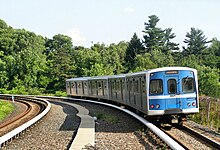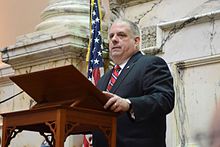Red Line (Baltimore)
The original project was granted federal approval to enter the preliminary engineering phase and the Maryland Transit Administration had spent roughly $300 million in planning, design and land acquisition, until Maryland Governor Larry Hogan declared his intent to not provide state funds for the project and shift state funding to roads in suburban areas.
[1] Hogan's shift of state priorities to road funding has resulted in the construction of several major projects near properties owned by his company, leading to allegations of corruption.
Two features of the original Alternative 4C plan, considered important by the Citizens Advisory Council, remained part of the Locally Preferred Alternative: With the Federal Transit Administration's approval in June 2011 to start preliminary engineering, the project made its first step beyond the concept stage; however, the FTA estimated daily ridership for the completed system at 57,000 and expected it to cost a total of $2.2 billion with inflation included.
[12] The complaint challenged Governor Hogan's decision to cancel the Red Line on the basis of discrimination against Baltimore's predominantly African American population that would have benefited from the infrastructure project.
[13] Furthermore, the complaint highlighted that Governor Hogan's decision shifted funding away from public transportation dependent citizens, and instead was dedicated towards highway projects in primarily white rural and suburban areas of the state.
[12] On January 19, 2017, the last day of the Obama Administration, the Department of Transportation announced it expanded its investigation into Governor Hogan's decision to cancel the Red Line, as well as the rest of MDOT's programs to determine whether federal law was violated.
Starting from the west, the proposed stations were as follows: The "Citizens' Advisory Council for the Baltimore Corridor Transit Study - Red Line" was established by the Maryland General Assembly in 2006.
On September 9, 2008, the Red Line Citizens' Advisory Council voted unanimously to adopt its first report to the General Assembly, which included the statement that "Preparation of a SDEIS [Supplemental Draft Environmental Impact Statement] should begin now, as a collaborative effort between the MTA and the public in finding the best ways to invest over a billion dollars in Baltimore's transportation infrastructure in keeping with the vision of the 2002 Plan."
Beginning in late 2008, Baltimore City favored the "4C Alternative" selected by Governor O'Malley in 2009, which was endorsed by Mayor Sheila Dixon; however, the 2008 Citizens Advisory Council annual report commented on the opposition of community groups to surface rail alignments through residential neighborhoods.
Its now-defunct website explained that the organization considered the proposed light rail alignment to be a detriment to communities on both the East and West sides of Baltimore.
In the summer of 2011 the Red Line Now Political Action Committee (PAC) was established to voice the support of residents of Baltimore City for the funding and construction of Alternative 4C.
This provision was sought by Maryland Senator Ben Cardin with the intent to allow for the Red Line and other canceled transit projects to be renewed.
[21] On June 15, 2023, Governor Wes Moore announced that he would restart efforts to build the Red Line in a ceremony with Baltimore mayor Brandon Scott.
[22] The state Department of Transportation plans to identify possible route alignments, gauge public feedback, and study the project's costs and benefits over the course of the rest of the year.






